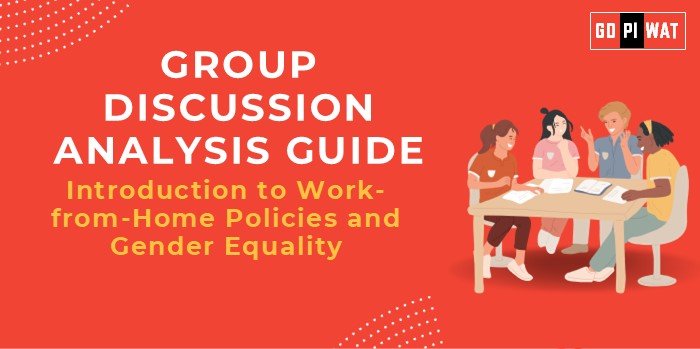📋 Group Discussion (GD) Analysis Guide
🌟 Introduction to Work-from-Home Policies and Gender Equality
- Opening Context: “Work-from-home policies have emerged as a transformative approach for modern workplaces, particularly post-pandemic, with the potential to reduce gender disparities in employment participation and leadership roles.”
- Topic Background: Historically, women have faced challenges balancing professional responsibilities with societal expectations, often leading to career interruptions. Work-from-home (WFH) offers a flexible solution to bridge gender gaps in career opportunities.
📊 Quick Facts and Key Statistics
- 🌍 Global Female Workforce Participation: 47% in 2023 (ILO report).
- 👩💼 Women’s Workforce Dropout: 43% of highly qualified women leave jobs after having children (McKinsey, 2023).
- 🏢 Remote Work Adoption: 50% of companies offer hybrid or remote work models globally.
- 📈 Gender Promotion Gap: Women held 28% of C-suite positions in 2023 (Deloitte Women in the Workplace report).
- 🇮🇳 India’s Female Labor Force Participation: 32% in 2023 (World Bank).
🏗️ Stakeholders and Their Roles
- 👔 Employers: Creating inclusive, remote-friendly policies to boost retention.
- 👩👧👦 Women Employees: Beneficiaries of flexibility to manage work-life balance.
- 🏛️ Government Agencies: Promoting labor policies that foster gender parity.
- 💻 Technology Providers: Ensuring digital accessibility for remote work success.
- 🌍 Society: Shifting cultural norms to support women’s professional growth.
🏆 Achievements and Challenges
✨ Achievements
- Retention and Re-entry of Women: WFH policies enable women to stay in the workforce post-maternity or family commitments.
- Example: Tata Consultancy Services reported higher retention of female employees post-WFH policy expansion.
- Leadership Opportunities: Flexibility reduces structural barriers, enabling more women to climb leadership ladders.
- Work-Life Balance: Women can efficiently manage caregiving roles while contributing productively to their careers.
- Global Adoption: Countries like Norway and Sweden with WFH norms showcase stronger gender inclusivity.
⚠️ Challenges
- Bias in Remote Roles: Women may face limited access to leadership roles due to visibility bias.
- Double Burden: Remote work often increases domestic expectations, exacerbating work pressure.
- Digital Divide: Limited digital access, especially in rural areas, restricts benefits for many women.
🌍 Global Comparisons
- 🇳🇴 Norway: Balanced work models reduced gender employment gaps by 15% in the past decade.
- 🇮🇳 India: Struggles with lower rural digital literacy, hindering equitable access to remote opportunities.
📖 Case Study
Infosys Hybrid Model (India): Demonstrated increased female participation post-COVID-19 by integrating remote flexibility and leadership training programs.
📋 Structured Arguments for Discussion
- Supporting Stance:
“Work-from-home policies empower women to participate in the workforce by eliminating geographic barriers and offering flexibility to manage familial responsibilities.” - Opposing Stance:
“Remote work may reinforce traditional gender roles, limiting women’s professional visibility and growth opportunities in leadership positions.” - Balanced Perspective:
“While WFH can bridge gender gaps in participation, companies must address visibility bias, double workload, and leadership opportunities to ensure gender equality.”
🗂️ Effective Discussion Approaches
Opening Approaches
- Statistical Opening: “Women make up only 28% of global C-suite leadership. Can WFH policies finally tip the scale?”
- Case-Based Opening: “Infosys saw a 12% rise in women returning to work due to hybrid models post-pandemic.”
Counter-Argument Handling
- Counter to Visibility Bias: “Regular check-ins, leadership mentorships, and tech platforms can ensure remote visibility and growth.”
- Counter to Double Burden: “Shared domestic responsibilities and organizational wellness initiatives can alleviate work stress.”
📊 Strategic Analysis of Strengths and Weaknesses
- Strengths: Increased female retention and workforce participation. Flexibility supports work-life balance.
- Weaknesses: Visibility bias in leadership roles. Uneven digital access limits WFH benefits.
- Opportunities: Leadership development programs tailored for women. Technological solutions for equitable remote access.
- Threats: Reinforcement of traditional gender roles. Work-life imbalance if proper policies are absent.
💡 Connecting with B-School Applications
- Real-World Applications: Implementing hybrid models, diversity and inclusion strategies, and organizational culture studies.
- Sample Interview Questions:
- “Do you think WFH can accelerate women’s leadership opportunities?”
- “What challenges do companies face in making remote work equitable for women?”
- Insights for B-School Students: Research the gender impact of flexible work policies. Explore organizational strategies to address remote visibility bias.


